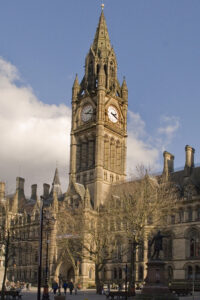Do you want to see London in a cozy yet socially distanced way? Or are you just the type who doesn’t like commuting using public transportation?
Driving a vehicle is probably the most sensible solution in these circumstances.
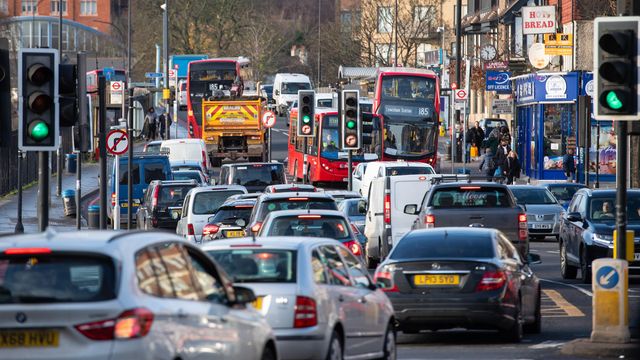
However, watch out! Before you hop in a car and drive around London, do you know that there is a London Congestion Charge?
The Congestion Charge applies to almost every vehicle coming to London (the Congestion Charge Zone), regardless of whether you are a tourist or a local.
If you do not want to pay for the Congestion Charge, do not stray into the Congestion Charge Zone.
Fortunately, this article will help you learn about everything there is to know about Congestion Charges in London.
In summary, here are the important topics on London Congestion Charge:
- What Is London Congestion Charge
- How Much Is London Congestion Charge
- How to Pay the Congestion Charge
- Where Is the Congestion Charge Zone
- How to Avoid the Congestion Charge
- What Is a Penalty Charge and Charge Certificate
- What Are London Congestion Charge Cameras
- Who Can Reimburse the Congestion Charge
- How to File a Congestion Charge Complaint
- How to Contact Congestion Charge
- Frequently Asked Questions
Contents
- 1 What Is London Congestion Charge
- 2 How Much Is London Congestion Charge
- 3 How to Pay the Congestion Charge
- 4 Where Is the Congestion Charge Zone
- 5 How to Avoid the Congestion Charge
- 6 Residents
- 7 Blue Badge holders
- 8 Breakdown vehicles accredited to BS EN ISO9001:2008
- 9 Motor tricycles
- 10 9-seater vehicles (9 or higher)
- 11 Battery electric or hydrogen fuel cell vehicles
- 12 Roadside recovery vehicle registered with the DVLA
- 13 What Is a Penalty Charge and Charge Certificate
- 14 What Are London Congestion Charge Cameras
- 15 Who Can Reimburse the Congestion Charge
- 16 How to File a Congestion Charge Complaint
- 17 How to Contact Congestion Charge
- 18 Frequently Asked Questions
- 18.1 Is Kings Cross in the Congestion Zone?
- 18.2 Do you pay Congestion Charge on Sunday?
- 18.3 How to check if I drove in Congestion Zone?
- 18.4 Is there an electric car Congestion Charge?
- 18.5 Is there a Congestion Charge on Boxing Day?
- 18.6 Was there a London Congestion Charge on the Queen’s Funeral?
- 18.7 Do I have to pay for the Ultra Low Emission Zone (ULEZ) fee even after paying the Congestion Charge?
- 19 Wrapping Up
What Is London Congestion Charge
If you are traveling with a car within the Congestion Charge Zone in London between 7:00 am and 6:00 pm from Monday to Friday, you will have to pay a Congestion Charge.
The charge also applies on the weekends and public holidays from 12:00 pm to 6:00 pm. The only holidays exempted from a Congestion Charge are the days between Christmas Day and New Year’s Day.
The system was taken after the Electronic Road Pricing (ERP) of Singapore and was officially initiated in 2003.
With the help of the Congestion Charge, the city aims to reduce traffic and pollution, improve people’s health, and boost the economy by encouraging people to ride public transportation.
The charges collected also go to the enhancement of public transportation.
Pay a Congestion Charge on these days and times
| Day | Time |
| Monday to Friday | 7:00 am to 6:00 pm |
| Saturday and Sunday | 12:00 pm to 6:00 pm |
| Public Holidays | 12:00 pm to 6:00 pm |
No Congestion Charge
| Day | Time |
| Monday to Thursday | 6:01 pm to 6:59 am (next morning) |
| Friday | 6:01 pm to 11:59 am (Saturday morning) |
| Saturday | 6:01 pm to 11:59 am (Sunday morning) |
| Sunday | 6:01 pm to 6:59 am (Monday morning) |
| Public Holidays | 6:01 pm to 6:59 am (next morning on a working day) or
6:01 pm to 11:59 am (next morning on Saturday, Sunday, or public holiday) |
| Between Christmas Day and New Year’s Day | No Congestion Charge |
How Much Is London Congestion Charge
The Congestion Charge costs £15 per day. It is already valid for the whole day, so even if you leave the Congestion Charge Zone and come back, you do not need to pay again.
You will only pay £15 if you paid on the day or before your travel.
However, you will be charged a higher price of £17.50 if you pay late at 12:00 midnight on the third day after you travel in the zone.
If you still haven’t paid after the third day, you will be fined and given a Penalty Charge Notice (PCN).
The penalty charge costs £160 but can be reduced to £80 if you paid it within two weeks.
How to Pay the Congestion Charge
There are several ways to pay for the Congestion Charge, all of which are done online for convenience. Make sure to only pay for the charge through official websites to avoid payment fraud.
The most effortless way to pay for the charge is through Auto Pay, which automatically creates the payment for you every month.
Alternatively, payment is possible by paying online in advance or on the same day. You can pay as early as three months before the date of travel. Another way to pay is through the TfL Pay to drive in London app.
The app is free to download via AppStore and Google Play Store and you can use it to pay for a variety of fees such as Congestion Charges and penalties.
It is also used to set up Auto Pay and help you check if a postcode is within a Congestion Charge Zone.
Moreover, you can save the vehicles you use so you do not have to keep registering every time you pay for the Congestion Charge.
Where Is the Congestion Charge Zone
Before driving in London, check the Congestion Charge Zones provided by the Transport for London (TfL).
You can search the map by typing the postcode or street to check for more specific results.
Generally, the Congestion Charge Zone covers these areas:
- City of London
- West End
- Finsbury
- Bloomsbury
- Liverpool Street Station
- Clerkenwell
- St Paul’s Cathedral
- Holborn
- Covent Garden
- Soho
- Waterloo Station
- London Bridge Station
- Picadilly Circus
- Mayfair
- Green Park
- James’s Park
- Westminster Tate Britain
- Vauxhall Bridge
The major roads within the Congestion Charge Zone are the following:
- Bishopsgate
- Borough High St.
- Blackfriars Rd
- Millbank
- Strand
- Oxford Street
The Congestion Charge Zone is bordered by the following roads:
- Marylebone Road
- Euston Road
- City Road
- Commercial St.
- Tower Bridge Rd
- New Kent Rd
- Vauxhall Bridge Rd
- Park Lane
Download the Congestion Charge Area map to see the Congestion Charge Zone, Charging Zone boundary, residents’ 90% discount area, and main roads within the zone.
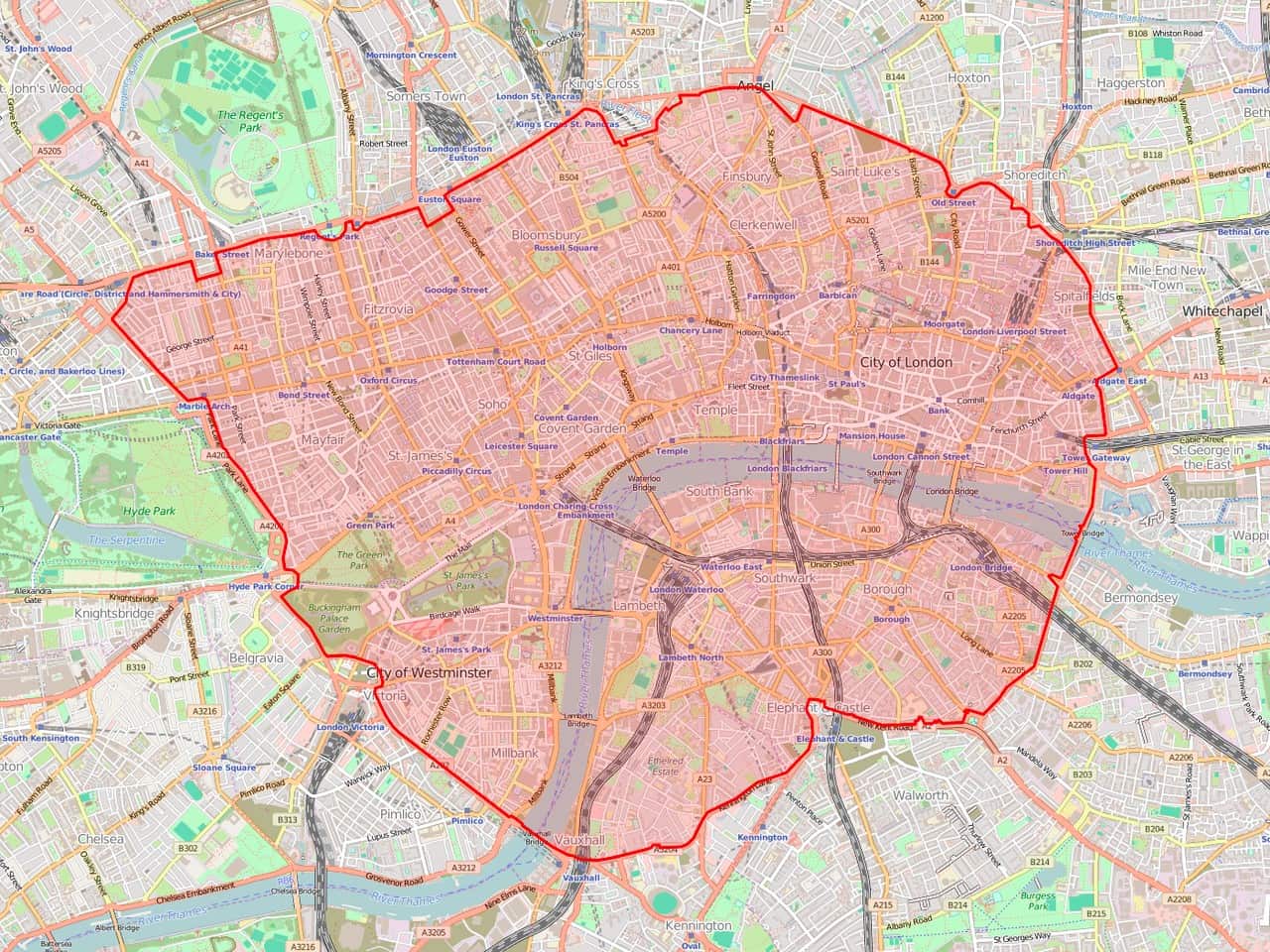
(Congestion Charge Zone Map by Ed g2s via Wikimedia Commons)
Know more about Congestion Charge Map.
Aside from the help of a map, you will also be advised that you are entering a Congestion Charge Zone when you see a sign with a red circular symbol with the letter “C” in it.
Here is an example of what you will normally see when driving in these zones.
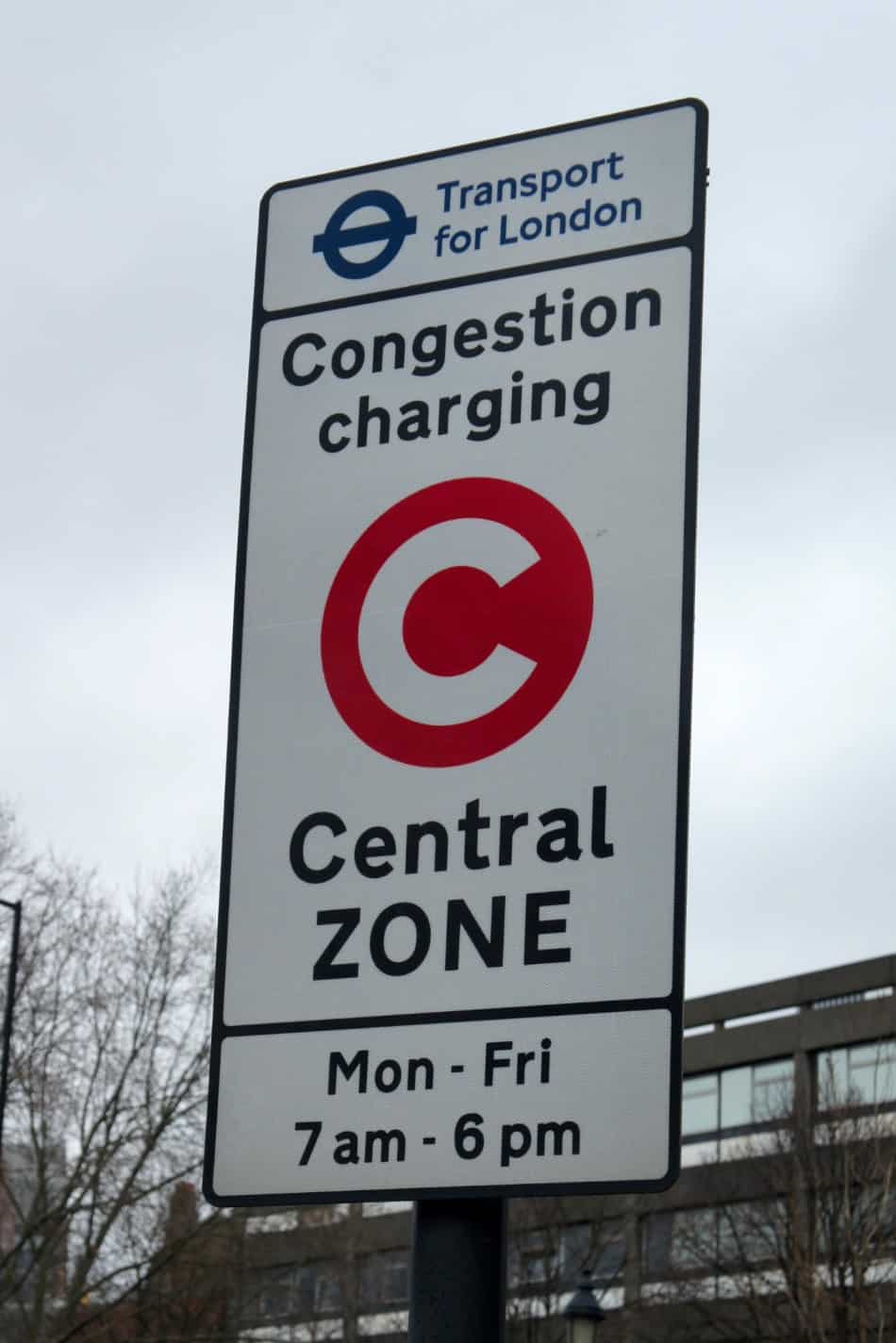
(Congestion Charge Logo by Mariordo via Wikimedia Commons)
How to Avoid the Congestion Charge
There is no other way to completely avoid the Congestion Charge if you choose to go into the Congestion Charge zone at a certain time but to ride public transportation and use your Oyster Cards and Travelcards to pay.
In fact, there are some methods that you can use to avoid the Congestion Charge.
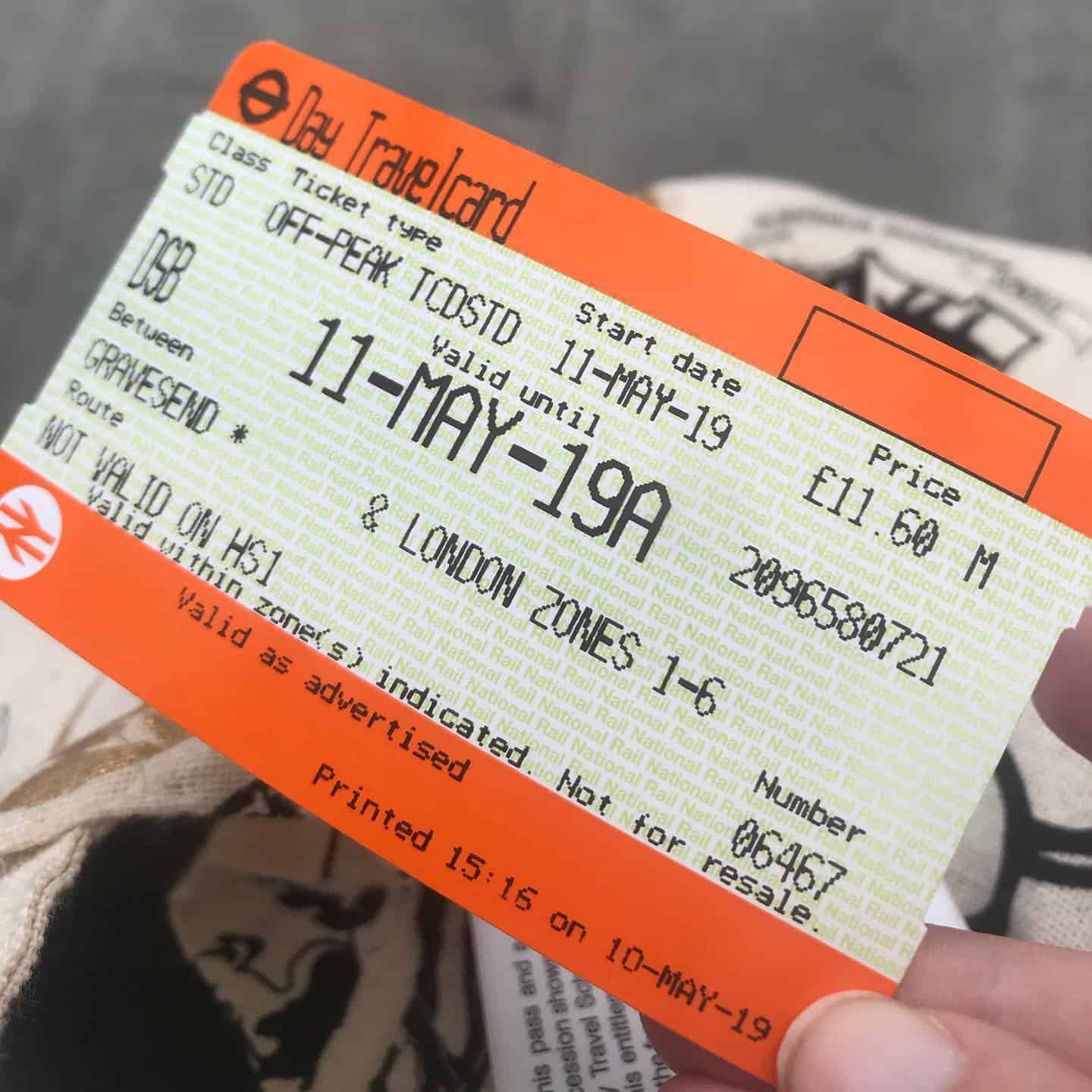
However, there are ways to get discounts and some exemptions to the charge if you are eligible.
Check with TfL if you can get discounts and exemptions.
Discounts and exemptions apply to the following:
- Residents – 90% discount
- Blue Badge holders – 100% discount
- Breakdown vehicles accredited to BS EN ISO9001:2008 – 100% discount
- Motor tricycles – 100% discount
- 9-seater vehicles (9 or higher) – 100% discount
- Battery electric or hydrogen fuel cell vehicles – Cleaner Vehicle discount
- Roadside recovery vehicle registered with the DVLA – 100% discount
If you are among the above-mentioned, here’s how you can apply for a discount or exemption.
Residents
If you are a resident within the residents’ discount zone, you get a 90% discount on the Congestion Charge Zone.
However, you need to pay £10 every year to register for the discount. Only those who are registered in the Parliamentary or local government and have a vehicle document can apply.
You can prove your residency by submitting a residential council tax bill, income support entitlement letter, bank or credit card statement, formal tenancy agreement or housing association rent documents, utility bill, and driving licence.
Blue Badge holders
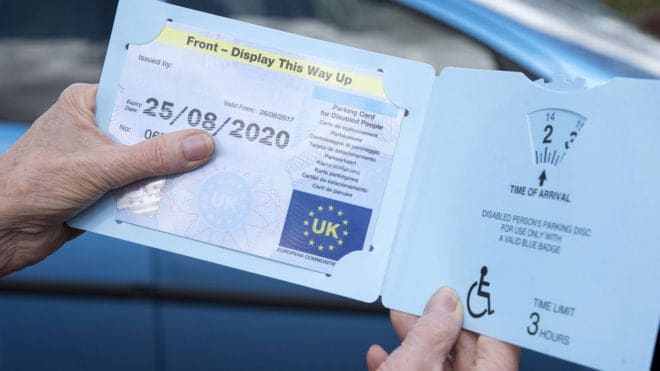
Blue Badge holders in the European Economic Area can apply for a full discount online, regardless of whether they own a vehicle or not.
A £10 registration fee is charged, which is renewed at the same time as your Blue Badge renewal.
To avail of the discount, you need to show a copy of your Blue Badge and proof of identification such as a passport, driver’s licence, bank or credit card statement, pension book, DSS benefit entitlement letter, birth certificate, marriage certificate, or Deed Poll Certificate.
Breakdown vehicles accredited to BS EN ISO9001:2008
Those with accredited breakdown vehicles can apply for a 100% discount online by submitting a copy of the current BS EN ISO9001:2008 certificate.
You also need to provide your PAS 43 certification and pay £10 for every vehicle registered.
The discount expires every year, so you will have to pay £10 to renew.
Motor tricycles
Motor tricycles with a maximum width of one meter and a maximum length of two meters can apply for a 100% discount and pay an annual fee of £10 per vehicle.
You need to submit an online application and provide a copy of the V5C registration document and pictures of all sides of the motor tricycle. The pictures should include the Vehicle Registration Mark.
9-seater vehicles (9 or higher)
If your 9-seater vehicle is not a bus and is registered outside the UK, you need to register with TfL to apply for a 100% discount.
You will pay £10 every year to renew your registration discount.
To apply online, you need to submit a vehicle registration document or V5C, MOT certificate, CIF or COIF (Certificate of Initial Fitness), an insurance document, and any proof that shows the number of seats of the vehicle.
Battery electric or hydrogen fuel cell vehicles
Originally called Ultra Low Emission Discount (ULED), vehicles that are classified as battery electric or hydrogen fuel cell can avail of the Cleaner Vehicle discount.
However, the Cleaner Vehicle discount will be discontinued from December 25, 2025.
If you still want to apply while the discount is still available, you need to provide a copy of your V5C vehicle registration certificate, or vehicle registration document (for non-UK registered vehicles), and pay a £10 registration fee once it is approved.
Roadside recovery vehicle registered with the DVLA
If your vehicle is registered as a recovery vehicle with the DVLA, you get a 100% discount on the Congestion Charge.
As long as TfL can see your registered vehicle under tax class 47, you do not need to provide documents when applying online.
However, if it is not registered, you need to submit a copy of the V5C vehicle registration certificate.
What Is a Penalty Charge and Charge Certificate
Penalty Charge
After the third day and you still haven’t paid the Congestion Charge, TfL sends you a Penalty Charge Notification as a standard notice.
You may be wondering – how do they know you entered the Congestion Charge Zone?
Of course, there are Congestion Charge cameras in the area and TfL takes photos of all vehicles entering the Congestion Charge Zone.
So if you are thinking of ways on how to get out of the Congestion Charge fine, there is no way to escape and avoid the charges since there is a recorded image of your vehicle.
If their data shows that you haven’t paid the charge by the third day at 12:00 midnight, that is the time they send you a PCN. The penalty charge is £160 or £80 if you pay it within two weeks.
You have 28 days to fully pay the PCN. However, if you believe you should not have been given a PCN, you can Challenge the PCN online or in writing within 28 days after the PCN was issued.
Some of the situations where you can challenge the PCN are when you have already paid the charge, your vehicle is eligible for a 100% discount or exempted from the charges, or you were not the user of the vehicle at that time.
Charge Certificate
The penalty charge will be thrice your supposed discounted fee of £80, giving you a £240 Charge Certificate if you do not pay it within 28 days.
The Charge Certificate is given to the registered user of the vehicle. Once you are issued a Charge Certificate, you have another two weeks to settle the penalty.
At this time, you no longer have the chance to challenge the PCN and will become mandatory to pay.
However, if you were still not given a response to your previous PCN appeal or were not even given a PCN before, you can apply for Statutory Declaration instead.
If you are still not able to pay for the Charge Certificate after two weeks, you will be issued an Order for Recovery and have a debt registration fee at the Traffic Enforcement Centre.
You will have additional 21 days to settle the remaining debt. In case you still haven’t paid in 21 days, the matter will be given to the enforcement agent.
They are the ones who will go to your residence and try to collect the debt and enforcement fees. Learn more about enforcement agents and your rights.
What Are London Congestion Charge Cameras
In order to issue a Congestion Charge, the TfL has 197 Congestion Charge cameras monitoring the exit and entrance of the streets.
All pictures taken by the cameras are called ‘Evidential Records’ (ER) to document those who will be required to pay the Congestion Charge.
With the camera’s Automatic Number Plate Recognition (ANPR) design, the plate number of the vehicle is included in the picture to know which registered user is charged the fee.
As soon as you pay the Congestion Charge, the photo of your vehicle will be deleted from the database.
However, if you haven’t paid the charge, the photo remains in the system and the PCN will then be issued to you. The PCN usually includes a notification with two pictures of your vehicle.
Once the PCN is paid, the ER of your vehicle is deleted from the database. Read “What do I need to know about the central London Congestion Charge camera system?” provided by TfL to learn more about it.
Who Can Reimburse the Congestion Charge
You may have heard of the possibility of reimbursements.
However, Congestion Charge reimbursements are only given to those who work or volunteer in charities, local authorities, home cares within the Congestion Charge Zone, and National Health Service (NHS).
If you are an NHS patient, you can also get a reimbursement of the charge.
NHS patients who need to travel to the hospital through the Congestion Charge Zone can make a claim after paying for the Congestion Charge.
You cannot make a claim when you have not traveled through the Congestion Charge Zone and paid the necessary fees.
Moreover, the NHS hospitals are the ones who usually ask the reimbursement for you.
How to File a Congestion Charge Complaint
Dissatisfied with the Congestion Charge service provider? You can file a Congestion Charge complaint in three steps.
First, make a complaint by sending a complaint online, by phone, or by mail. Generally, you can get a response within 10 business days.
Next, if you get a response and you still want to file a complaint, you can send a mail to the customer correspondence manager and wait for another 10 days for a response.
During this time, a thorough investigation is conducted to gather all necessary details.
Lastly, if you are still unsatisfied with the results of the complaint with the customer correspondence manager, you can ask for another investigation to the general manager.
After filing a complaint to the general manager and you still want to pursue your complaint, this will be handled by the Local Government Ombudsman (LGO) already.
You have to fill up the complaint form in order for the LGO to investigate the matter further. Read first about their process for making a complaint before sending them a complaint.
How to Contact Congestion Charge
If you have questions about Congestion Charge, you can send an inquiry online and select the type of inquiry.
You can ask about general topics, penalty charges and enforcement, Auto Pay, fleet, payment, and ULEZ. It is also where you can attach supporting documents to your inquiry.
As additional information, you may need to input your previous reference number, vehicle’s plate number, receipt number, or Penalty Charge Notice (PCN) number.
Another way to contact TfL is by phone from Monday to Friday between 8:00 am and 8:00 pm. You can check the complete list of Phone numbers for UK, international, and textphone.
Frequently Asked Questions
Is Kings Cross in the Congestion Zone?
When you use the Map Search of TfL, Kings Cross is just outside the Congestion Charge Zone.
If you also search Kings Cross Station, you will see that it is also outside the boundaries of the Congestion Charge Zone.
Do you pay Congestion Charge on Sunday?
Even if you drive in the Congestion Charge Zone on a Sunday, you will still have to pay the Congestion Charge of £15.
When you travel on the weekends between 12:00 pm and 6:00 pm, you need to pay the charge.
However, if you drive outside the mentioned times, then you do not have to pay the charge.
How to check if I drove in Congestion Zone?
You can easily check if you drove in the Congestion Charge Zone by typing the postcode or street in the Map Search of TfL.
Otherwise, you will be notified by TfL if you need to pay for the charge since you are the registered user of the vehicle.
Is there an electric car Congestion Charge?
Electric cars are under the Cleaner Vehicle Discount, which means they are exempted from paying the Congestion Charge.
As long as you are able to provide a document that clearly states that the vehicle is classified as battery electric or hydrogen fuel cell vehicle, then you do not have to pay for the charge.
Is there a Congestion Charge on Boxing Day?
Yes, the Congestion Charge is still issued on Boxing Day. In fact, Motorists had to pay the Congestion Charge for the first time back in 2020 as reported by the Evening Standard.
Was there a London Congestion Charge on the Queen’s Funeral?
Yes, the Congestion Charge was still issued on the day of the Queen’s funeral. Several roads were closed in Central London on this day.
The Travel advice for the period of mourning given by TfL was to use public transportation instead of driving a car.
Do I have to pay for the Ultra Low Emission Zone (ULEZ) fee even after paying the Congestion Charge?
The ULEZ charge is £12.50 daily. You only need to pay the charge if your vehicle does not meet the ULEZ emissions standards.
Even if you are a resident of the Congestion Charge Zone, you will still need to pay the fee if you are driving within ULEZ with a non-standard vehicle.
Further Reading for Driving in the UK.
- Driving in London is one of the best options if you plan to have a road trip within London.
- Want to check your driving licence online? Check out our guide to How To Check Status Of Driving Licence.
- Want to drive in the UK legally? You need a driving licence first. Follow these Steps to Get a Driving Licence in the UK.
- Before you decide to get a driving licence, you may want to know how much you are going to spend before applying for one. Check out our guide to how much for a driving licence.
- Choose one of the Best Driving Schools in London if you decide to learn to drive and get a full driving licence.
- You may want to know How Many Driving Lessons You Need to Pass the Driving Test.
- How much time should I spend on learning to drive? Read our guide to How Long Does It Take To Learn to Drive.
- Applying for the driving licence, but don’t know how to fill in the form? Download INF1D Booklet and read our guide to solve the problem.
- After applying for your driving licence, you may want to track your driving licence and know whether it is legal to drive if your Driving Licence Has Not Arrived.
- After getting your driving licence, you may be happy to learn more about it. Check out our guide to UK Driving Licence Explained.
- If you are unlucky Losing your driving licence, it is not the world’s end, follow our detailed guide to Lost Driving licence UK | How To Replace And Apply.
- Can’t find out your Driving Licence Number? Don’t worry about it, here is a step-by-step guide to How to Get Driving Licence Number if Lost.
- Unfortunately, you get a Private Parking Ticket, but you don’t know how to deal with it. Should you pay for it? Check out our guide to Do You Have To Pay Private Parking Tickets.
- You may want to buy Car Insurance but don’t know how to buy it. Check out our guide to A Comprehensive Guide on Car Insurance in the UK.
- Can’t Remember your Car Insurance Company? Check out our guide to Who Am I Insured With.
- If you forgot your Car Insurance Expiry Date and want to find it out, here is our guide to 5 Ways To Check your Car Insurance Expiry Date.
Wrapping Up
Thanks to the Congestion Charge, traffic has ultimately reduced in Central London and boosted public transportation revenue.
If you do not mind paying the fees, then driving through the Congestion Charge Zone won’t be a problem at all.
However, if you want to be economical, it is best to use public transportation and help reduce pollution in your own little way.
Avoiding the charges is only possible if your vehicle is eligible for discounts or exemptions.
The only way to not pay the charge when driving through the Congestion Charge Zone is if you drive outside the charge hours between 6:01 pm and 6:59 am the next day from Monday to Thursday, on Friday from 6:01 pm to 11:59 am the next day, or between 6:01 pm and 11:59 am the next day on Saturday, Sunday, and public holidays.
Hopefully, this detailed guide is able to help you understand more about the Congestion Charge and clear up any questions you may have about it.
What do you think about the Congestion Charge issued in London? If you have your own recommendations about the charge, write them down below in the comments section.

